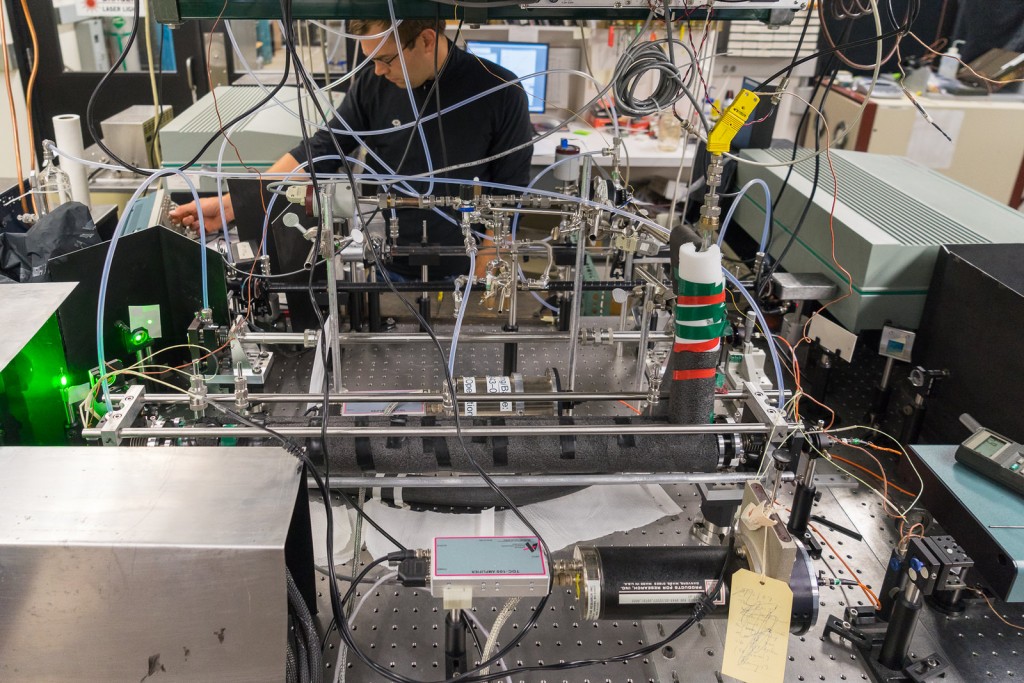3 November 2015
WASHINGTON, DC — Some substitutes for ozone-damaging chemicals being phased out worldwide under international agreements are themselves potent greenhouse gases and contribute to warming. Now, a new study published Nov. 2 in Geophysical Research Letters, a publication of the American Geophysical Union, shows for the first time how some of those replacement chemicals can break down in the atmosphere to form a greenhouse gas that can persist for millennia, much longer than the substitute chemicals themselves.
Specifically, when some chemicals widely used as refrigerants break down in the stratosphere—a layer in the middle atmosphere—under some conditions, they can form a potent greenhouse gas that lasts for up to 50,000 years, according to scientists from the Cooperative Institute for Research in Environmental Sciences (CIRES) at the University of Colorado Boulder and the NOAA Earth System Research Laboratory (ESRL) in Boulder.
“This compound, carbon tetrafluoride or CF4, essentially lasts forever because there aren’t any known removal mechanisms in the atmosphere,” said James Burkholder, a research chemist at NOAA ESRL and lead author of the study.
Burkholder’s colleague Aaron Jubb, a CIRES scientist working at NOAA ESRL and now at Oak Ridge National Laboratory, did the laboratory work showing how CF4 can be made from some halocarbons, chemicals that include hydrofluorocarbons (HFCs) and hydrochlorofluorocarbons (HCFCs) and are substitutes for the more ozone-damaging chemicals that have largely been phased out. Jubb started with trifluoroacetyl fluoride—a compound produced in the atmosphere when some halocarbons breaks down—exposed it to short-wavelength UV radiation, and looked at the reaction products that formed. CF4 was one of those breakdown products.

Aaron Jubb works on a laboratory setup used to measure the reactivity and photochemistry of atmospherically relevant species.
Credit: Will von Dauster/ NOAA.
The amount of CF4 produced by this photochemical process was shown to be a small fraction of atmospheric CF4; industrial sources are much larger emitters of CF4. Still, identifying this particular source of such a potent and lasting greenhouse gas is important, particularly since its production could continue to grow depending on which “parent” products are used by industry.
“We really need to understand the chemistry of the compounds we use,” Jubb said. “Even as we move towards shorter-lived halocarbons for industrial use, during atmospheric degradation they can produce a long-lived atmospheric effect.”
This work was supported in part by NOAA’s Atmospheric Chemistry, Carbon Cycle, and Climate (AC4) Program and NASA’s Atmospheric Composition Program.
CIRES is a partnership of NOAA and CU-Boulder.
###
The American Geophysical Union is dedicated to advancing the Earth and space sciences for the benefit of humanity through its scholarly publications, conferences, and outreach programs. AGU is a not-for-profit, professional, scientific organization representing more than 60,000 members in 139 countries. Join the conversation on Facebook, Twitter, YouTube, and our other social media channels.
Notes for Journalists
Journalists and public information officers (PIOs) of educational and scientific institutions who have registered with AGU can download a PDF copy of the article by clicking on this link: http://onlinelibrary.wiley.com/doi/10.1002/2015GL066193/abstract
Or, you may order a copy of the final paper by emailing your request to Lauren Lipuma at [email protected].
Please provide your name, the name of your publication, and your phone number.
Neither the paper nor this press release is under embargo.
“An atmospheric photochemical source of the persistent greenhouse gas CF4”
Authors:
James B. Burkholder: NOAA Earth System Research Laboratory (ESRL) Chemical Sciences Division, Boulder, Colorado, USA;
Aaron Jubb: Cooperative Institute for Research in Environmental Sciences and NOAA ESRL Chemical Sciences Division, now at Oak Ridge National Laboratory, Oak Ridge, Tennessee, USA;
Max McGillen: Cooperative Institute for Research in Environmental Sciences and NOAA ESRL Chemical Sciences Division, Boulder, Colorado, USA;
Robert W. Portmann: NOAA ESRL Chemical Sciences Division, Boulder, Colorado, USA;
John S. Daniel: NOAA ESRL Chemical Sciences Division, Boulder, Colorado, USA.
Contact Information for the Authors:
James Burkholder: [email protected], +1 (303) 497-3252
Aaron Jubb: [email protected]
Lauren Lipuma
+1 (202) 777-7396
[email protected]
CIRES contact:
Karin Vergoth
+1 (303) 497-5125
[email protected]